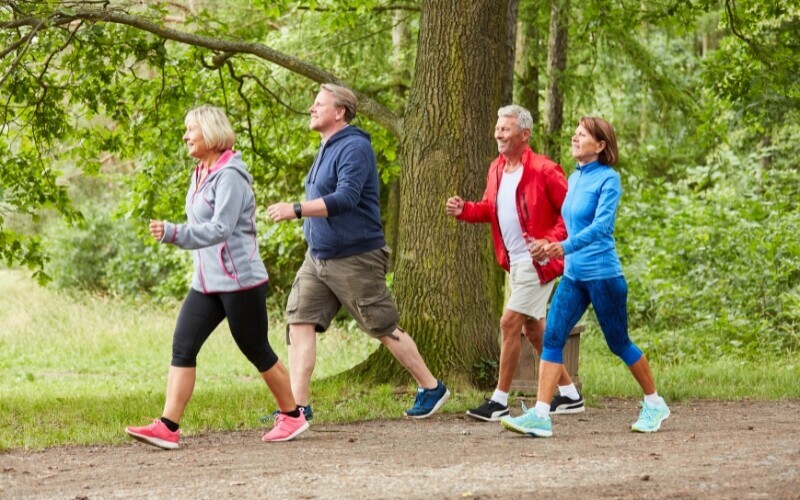Walking is an excellent form of exercise you can easily incorporate into your daily routine. It’s important to follow some essential tips on walking for exercise – to maximize its benefits.
From proper footwear to interval training, these guidelines can enhance your walking routine, making it more enjoyable and effective for your overall well-being.
Here are 10 detailed tips to help you make the most of your walking workouts:
1-Wear Proper Footwear:
Investing in a quality pair of walking shoes is crucial for comfort and injury prevention.
Look for shoes with a good arch support, cushioning, and a snug fit to accommodate your foot shape.
Proper footwear helps absorb shock, reduces the risk of blisters, and supports your joints, making your walk more enjoyable and effective.
Women’s Walking Shoes
New Balance Women’s 608 V5 Cross Trainer Shoe
Brooks Women’s Adrenaline GTS 22 Supportive Running Shoe
Men’s Walking Shoes
New Balance Men’s 608 V5 Casual Comfort Cross Shoe
Under Armour Men’s Charged Assert 10 Shoe
This post contains affiliate links. If you click on and purchase through one of those links, you won’t pay a penny more, but we’ll get a small commission, which helps keep our website operating. Thanks! As an Amazon Associate, I earn from qualifying purchases.
2-Start Slow and Gradually Increase:
If you’re new to walking for exercise, start with shorter distances at a comfortable pace.
Gradually increase the length and intensity of your walks over time.
This approach helps build endurance and strength without overwhelming your body.
It will reduce the risk of injury and ensure long-term sustainability.
3-Maintain Good Posture:
Proper posture enhances your walking efficiency and prevents strain on your body.
Keep your head up, shoulders relaxed, and back straight. Engage your core muscles and swing your arms naturally at your sides.
Good posture not only improves breathing but also distributes your weight evenly, reducing the risk of musculoskeletal issues.
4-Warm Up and Cool Down:
Begin each walk with a 5–10-minute warm-up of gentle walking and dynamic stretches to prepare your muscles.
Similarly, end your walk with a cool-down period of slower walking and static stretching.
This routine helps increase blood flow, reduce muscle stiffness, and prevent injuries by gradually adjusting your body to and from activity.

5-Stay Hydrated:
Hydration is key to maintaining energy levels and preventing dehydration. This is especially important during longer walks or in hot weather.
Drink water before, during, and after your walk. Carry a water bottle if you’re planning an extended walk.
Proper hydration helps regulate body temperature, lubricate joints, and transport nutrients, enhancing overall performance.
6-Mix Up Your Routes:
Walking the same route can become monotonous. Vary your paths to keep things interesting. Challenge your body with different terrains, like hills, parks, or trails.
This variation not only stimulates your mind but also engages different muscle groups, improving overall fitness and preventing a workout plateau.
7-Use Interval Training:
Incorporate intervals of faster walking or jogging into your routine.
For example, alternate between one minute of brisk walking and two minutes of moderate walking.
Interval training increases cardiovascular fitness, burns more calories, and enhances endurance.
It adds intensity to your workout, making it more effective without significantly extending duration.
8-Listen to Your Body:
Pay attention to any signs of discomfort or pain.
Mild soreness is normal, but persistent pain indicates a need for rest or medical consultation.
Over-training can lead to injuries, so it’s important to give your body time to recover.
Adjust your pace, distance, or frequency if necessary to ensure a safe and sustainable walking routine.
9-Track Your Progress:
Using a pedometer, fitness tracker, or mobile app. This can help you monitor your steps, distance, and time.
Setting goals and tracking your progress keeps you motivated and accountable.
Seeing improvements over time, like increased distance or faster pace, provides a sense of accomplishment and encourages consistency.

10-Join a Walking Group or Find a Walking Buddy:
Walking with others can make the exercise more enjoyable and help you stay committed.
A walking buddy or group provides social interaction, motivation, and accountability. It’s a great way to meet new people, share tips, and make your exercise routine more engaging and fun.
By incorporating these tips into your walking routine, you can enhance the effectiveness of your workouts, stay motivated, and enjoy numerous health benefits.
Walking is a simple, accessible form of exercise that, when done correctly, can significantly improve your physical and mental well-being.
In Summary
Incorporating these 10 tips on walking for exercise into your routine can transform a basic activity into a comprehensive fitness regimen.
By staying mindful of posture, hydration, and gradually increasing intensity, you can achieve significant health benefits.
Walking with friends or using interval training adds variety and motivation, ensuring you stay committed to your fitness goals.
Disclaimer: If you have any concerns or questions about your health, you should always consult with a physician or other healthcare professional. No content on this site should be substituted for direct medical advice from your doctor or other qualified healthcare practitioner. The information contained here is for informational purposes only. It is from my research and personal experience.
Related Posts
Surprising Ways Walking Reduces Anxiety
11 Heart Healthy Activities for Adults
Benefits of Nordic Walking Poles for a Full-Body Workout

